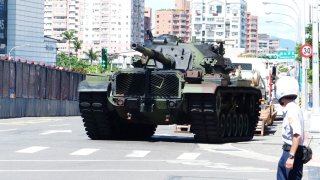Could Taiwan Withstand Chinese Aggression?
As Lee Hsi-ming put it, “It is the onus of the Taiwanese people to decide their fate and fight for their existence.”
Here's What You Need to Remember: Taiwan’s military must be able to survive the initial wave of PLA strikes against the country’s critical assets and infrastructure, retaining the ability to counterattack following the initial PLA assault.
In the midst of an unprecedented wave of threats and provocations from Beijing, Taipei is rapidly reforming its armed forces and modernizing key parts of its military. Taiwan’s ongoing efforts run parallel to a new holistic approach known as the Overall Defense Concept (ODC). But what exactly is the ODC, and how does it seek to change Taiwan’s defense posture?
The ODC was formulated in the late 2010s by former Chief of General Staff, Admiral Lee Hsi-ming. Described by former U.S. Defense Department official Drew Thompson as “a revolutionary new approach to Taiwan’s defense,” the ODC is based on the core strategic realization that Taiwan’s military cannot win a conventional war against China in the Taiwan Strait, nor can it impose decisive costs on the People’s Liberation Army (PLA) through attrition. Not only can this underlying reality not be meaningfully altered, but the gulf in conventional military capabilities between China and Taiwan is only likely to grow in coming decades as the PLA continues to modernize at a breakneck pace. Thus, according to the ODC’s proponents, Taiwan must adopt an asymmetric defensive posture to ensure its security in the coming decades. That is, the country must focus its limited resources on deterring and, if that fails, defeating a Chinese invasion and occupation of Taiwan.
One of the ODC’s core pillars is force preservation. Taiwan’s military must be able to survive the initial wave of PLA strikes against the country’s critical assets and infrastructure, retaining the ability to counterattack following the initial PLA assault. This approach includes electronic counter-countermeasures (ECCM) like anti-jamming and redundant/decentralized communications systems, as well as a force composition focus on mobility and concealment. Force preservation has become especially important with the rapid growth of Chinese anti-access, area-denial (A2/AD) capabilities in the Pacific; the PLA may not be able to defeat US assets in the Pacific outright, but it has the means to contain and delay U.S. forces long enough to complete its occupation of Taiwan. Thus, according to the ODC, it falls on the Taiwanese military to deny the Chinese invasion force for as long as possible. Asymmetric weapons systems, including sea mines, certain types of advanced unmanned aerial vehicles (UAVs), and coastal missile defense installations, are crucial to this endeavor, as are the recent army reforms empowering regional commanders to make time-sensitive decisions concerning troop movements and deployments in a decentralized fashion. Although Lee Hsi-ming went to great lengths to stress that Taiwan “would appreciate any assistance from Washington” and that continued U.S. military support is integral to the country’s security, the plan’s core tenets are designed to stand on their own in the worst-case scenario of no U.S. military assistance. “Taiwan’s military will not assume that the U.S. will sacrifice American lives to defend the island,” he wrote in an explanatory article published by The Diplomat.
Taiwan will seek to inflict the most damage on the invading forces in the littoral zone, where their home-field advantage is the greatest. Taiwanese forces will then shift to preventing the PLA from establishing beachheads. If the PLA gets boots on the ground, then not just the army but also the civilian population will be mobilized for a whole-of-society guerilla effort to prevent the occupying forces from advancing inland and establishing re-supply chains. At that point, every Taiwanese citizen will be conscripted into what could escalate into a wholesale urban war. As Lee Hsi-ming put it, “It is the onus of the Taiwanese people to decide their fate and fight for their existence.”
Mark Episkopos is a national security reporter for The National Interest.
This article is being reprinted due to reader interest.
Image: Wikipedia Commons

